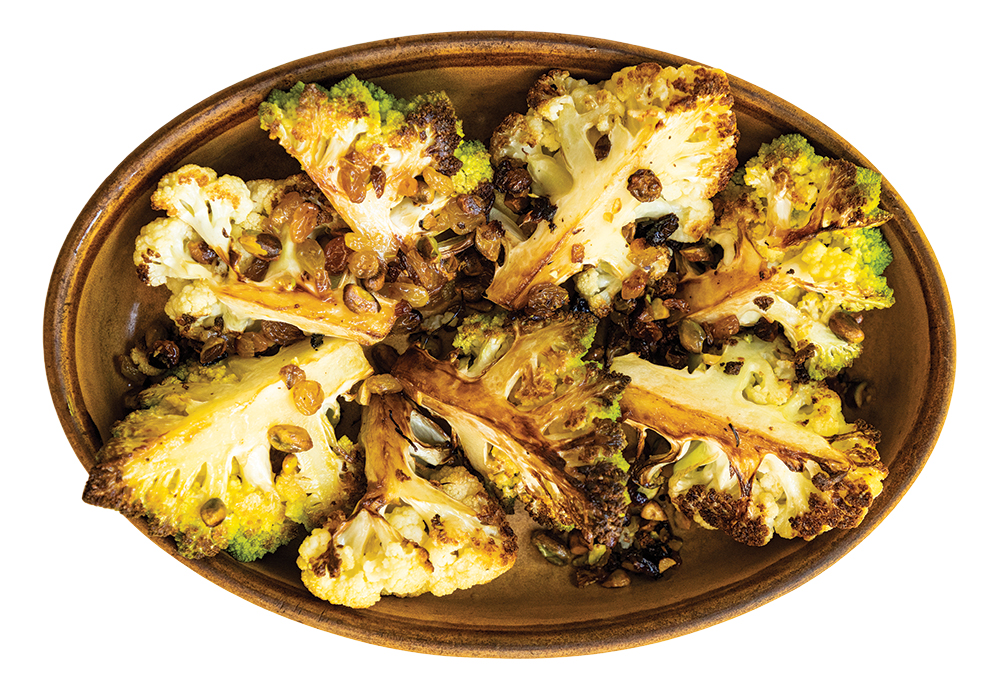
Cauliflower seems almost ubiquitous on menus and in cookbooks right now. Perhaps because of its wonderful flavor and versatility, perhaps because of fad diets. Its meteoric rise in popularity began when the nation discovered it could be mashed or pureed like potatoes and used as a starch substitute for those on low-carb diets. In fact, when very smoothly puréed with oil or butter and cream, it is truly delicious and velvety—even more so if you put a little cooked potato in the purée, but that breaks the anti-starch rule for those on low-carb diets. “Riced” cauliflower—when you pulse it in a food processor until it achieves the approximate size of rice grains, can be a passable substitute for actual rice—if you can’t eat actual rice. And cauliflower pizza crust—in my book, that variation isn’t so successful—especially if what you really want is a great pizza. Tempura-battered and fried, dipped in something spicy—remarkable. I love it simply roasted, with a few simple garnishes. So for those seeking a tasty, versatile and diet-friendly vegetable, look no further.
A surprising thing about cauliflower is just how nutritious it is. We’ve been told so many times that deeply colored vegetables have more nutrients, but white cauliflower is an exception to that rule. Although around 92 percent water, it is extremely high in vitamin C, the B vitamins and vitamin K. If you want to take that to another level, try some of the intensely colored varieties of cauliflower available now, such as the golden “Cheddar” cauliflower (high in beta carotene) and the purple variety (high in anthocyanins). All are fascinating in appearance. The brilliant chartreuse Romanesco cauliflower (sometimes called a broccoli) with its striking fractal spirals is a truly beautiful vegetable. All are delicious and taste like, well, cauliflower. Regardless of the variety, take advantage of the season and explore our farmers markets before it gets too hot for this remarkable vegetable to grow in our climate. Otherwise, you’ll have to wait until the next cool season to taste the best specimens of cauliflower at their finest.
Roasted Cauliflower
Quarter a head or two of cauliflower right through the stem, trimming the stem if it is discolored on bottom. If you have multiple colors/varieties of cauliflower it makes for a striking presentation. Place the cauliflower segments on a sheet pan or baking dish and drizzle them with extra-virgin olive oil. Season it generously with salt and a pinch of crushed red pepper flakes. Add a few smashed cloves of garlic, and if you like—and I like—a small handful of golden raisins and some type of nut like pine nuts or coarsely chopped walnuts or almonds. If you want to get really crazy, chop up an anchovy or two and add that as well. Gently toss everything together in the oil until it is completely coated and arrange it with one of the cut sides of each cauliflower segment flat against the bottom of the pan. Tuck any stray bits of garlic (and raisins and nuts if using) up next to the cauliflower so they aren’t as likely to burn. Cover the dish with foil or a lid and roast at 375 degrees for about 20 minutes. Remove the cover and adjust each piece of cauliflower so that the other flat side of the segment is in direct contact with the bottom of the pan—it gets better caramelization that way. Stir the garnishes in the pan around a bit, pushing them back up next to the segments and continue to roast the cauliflower uncovered for another ten or so minutes until the cauliflower is tender when poked with a knife and has a pleasing caramelized color all over.* Serve directly from the roasting pan or arrange the cauliflower in a serving dish and sprinkle the nuts and raisins and bits of toasty garlic all over and around. This is a great dish served warm or at room temperature. Leftovers can be cut into smaller bits and dressed with a vinaigrette or added to a salad, so not one single delicious bite gets wasted. Enjoy!
*Note: For another variation, you could sprinkle some oiled breadcrumbs on top of the cauliflower for that last ten minutes for an added layer of crispy-crunchy texture.
In Your Pantry: Brassicas

Brassicas are members of the mustard family—also known as cruciferous vegetables. If you’re bored with cabbage, turnips, and broccoli, give these a try. It can never hurt to have a few more varieties in your culinary repertoire.
Romanesco
The most striking of the brassicas with its pointy Fibonacci-number spirals (look it up), this cauliflower variety is the mildest in flavor and is wonderful steamed and tossed in salads, especially with seafood and a few drops of lemon juice and olive oil.
“Cheddar” or Orange Cauliflower
Thanks to the color, this named variety of cauliflower (a naturally occurring mutation discovered in a cauliflower field in Canada) is cheddar-colored—but there is no cheese flavor here. If want cauliflower and cheese soup, you’re still going to have to add cheese. But its generous dose of beta carotene would make a considerable contribution to an intensely colored cauliflower and actual cheddar cheese soup.
Broccolini
When a head of broccoli just seems like too much work, try this long-stemmed baby broccoli variety. There’s no need to break down the head and peel the stems, it cooks quite rapidly and contains less of the sulfurous flavor quality of larger broccoli heads that children (and many adults) dislike. Extra-virgin olive oil, garlic, and crushed red pepper are the perfect companions. For a little extra savor, throw in an anchovy or two.
Baby Bok Choy
Try this beautiful little green when you can’t decide between a salad and a warm side dish. Split it in half and toss it in a hot skillet with a little peanut oil, some sliced garlic, and a little Thai chili. In just a minute or two you have a slightly wilted yet crunchy, flavorful vegetable. Finish it with a little salt or a good splash of soy sauce and maybe a handful of crushed peanuts.

